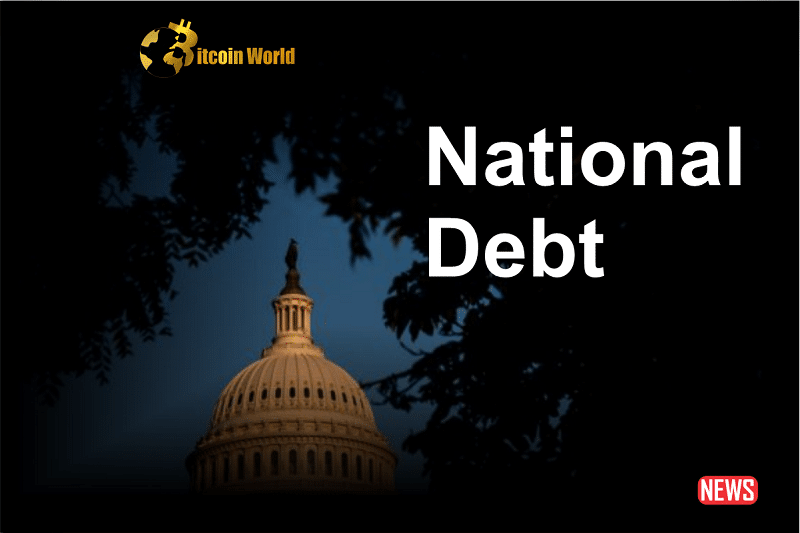Hold on to your hats, folks! The US national debt has just blasted past the $32 trillion mark, and it happened faster than you can say “fiscal responsibility.” In a mere two weeks, the debt ballooned by a staggering $571 billion. That’s a number so big, it’s hard to even wrap your head around. So, what does this mean for you, me, and the future of the American economy? Let’s dive in.
The Debt Spiral: How Did We Get Here?
According to the latest data from FiscalData, this rapid increase puts the total US national debt at a level exceeding the combined GDP of economic powerhouses like China, Japan, Germany, and the UK. Think about that for a second. To put it in even more personal terms, the average American household is now carrying a debt burden of approximately $244,000. And the daily interest payments? A cool $2 billion every single day. That’s like funding a small country’s annual budget daily, just to service our debt.
Can We Ever Pay It Back? The Daunting Reality
Let’s paint a picture. Imagine every single household in America chipping in $1,000 every month to tackle this mountain of debt. Sounds like a decent effort, right? Well, even with that collective contribution, it would still take a jaw-dropping 20 years to pay off the principal alone. And that doesn’t even factor in the ever-growing interest! The reality is, most experts believe this situation isn’t going to magically improve anytime soon. In fact, many predict it will get significantly worse in the coming decade, potentially jeopardizing America’s financial stability.
What Are the Experts Saying? Sounding the Alarm Bells
The experts aren’t exactly painting a rosy picture. Nigel Green, the CEO of deVere Group, has issued a stark warning, suggesting that the US national debt is more likely to hit a staggering $50 trillion than to actually decrease. He points out that if the debt continues its upward trajectory, any significant economic downturn could make it incredibly difficult for the US to meet its financial obligations. Adding to the chorus of concern is renowned investor Ray Dalio of Bridgewater Associates. He describes the US as teetering on the edge of a “very classic late big-cycle debt crisis.” These aren’t casual observations; these are serious warnings from seasoned financial minds.
The Tightrope Walk: Balancing Act or a Fall Waiting to Happen?
So, what’s the solution? It’s a delicate balancing act. As Ray Dalio highlights, a sufficiently high interest rate is needed to attract investors who are willing to buy US debt. Think of it as offering a tempting reward for lending money. However, as the debt grows larger and larger, maintaining this equilibrium becomes increasingly difficult. It’s like trying to balance a tower of blocks that keeps getting taller and more unstable. If this balancing act fails, the consequences for the US economy could be severe.
The Road Ahead: Challenges and Potential Solutions
The sheer scale of the US national debt presents a multitude of challenges:
- Increased Interest Payments: A larger debt means higher interest payments, diverting funds that could be used for other crucial areas like infrastructure, education, or research.
- Risk of Inflation: Excessive borrowing can lead to inflationary pressures, eroding the purchasing power of the dollar.
- Reduced Economic Growth: High debt levels can stifle economic growth as governments may need to implement austerity measures or raise taxes.
- Diminished Global Influence: A nation struggling with debt may see its global economic and political influence wane.
- Increased Vulnerability to Economic Shocks: A large debt burden makes the economy more susceptible to external economic shocks.
While there’s no easy fix, some potential avenues for addressing the debt crisis include:
- Fiscal Discipline: Implementing measures to control government spending and reduce the budget deficit.
- Sustainable Economic Growth: Fostering an environment that encourages economic growth, which can increase tax revenues.
- Entitlement Reform: Addressing the long-term sustainability of entitlement programs like Social Security and Medicare.
- Tax Reforms: Considering tax reforms that could generate more revenue without hindering economic growth.
The Bottom Line: A Call for Action
The fact that the US national debt has surged past $32 trillion is not just a number on a spreadsheet; it’s a significant challenge that demands attention. Experts are raising valid concerns about a worsening debt crisis in the coming years, with some even predicting a jump to $50 trillion. As the debt continues its relentless climb, the ability of the United States to meet its obligations is increasingly under scrutiny. It’s clear that policymakers and financial institutions need to take decisive action, and they need to do it now. The future economic stability of the nation depends on it. Ignoring this issue is no longer an option; it’s time for a serious and sustained effort to address this growing crisis before it’s too late.
Disclaimer: The information provided is not trading advice, Bitcoinworld.co.in holds no liability for any investments made based on the information provided on this page. We strongly recommend independent research and/or consultation with a qualified professional before making any investment decisions.


